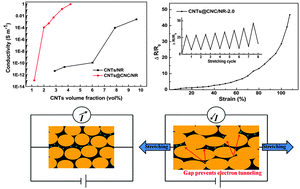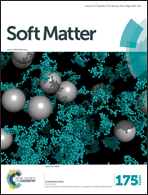Tailoring percolating conductive networks of natural rubber composites for flexible strain sensors via a cellulose nanocrystal templated assembly†
Abstract
Conductive polymer composites (CPCs) just above the percolation threshold exhibit a unique strain-reversible electric response upon application of tensile strain, which can be used to prepare strain sensors. However, it is difficult to balance the electric conductivity which is fundamental to a stable output signal and the strain sensing sensitivity due to the relatively dense conductive pathways of the traditional CPCs. Constructing a “brittle” but effective conductive network structure in CPCs is the essential foundation of a desirable sensing material. Here, we demonstrate for the first time that highly flexible, stretchable, sensitive, and reversible strain sensors can be fabricated by a facile latex assembly approach, in which nontoxic, sustainable and biodegradable cellulose nanocrystals played a key role in tailoring the percolating network of conductive natural rubber (NR)/carbon nanotube (CNT) composites. The resulting nanocomposites with a continuous 3D conductive structure exhibited a very low electrical conductivity percolation threshold (4-fold lower than that of the conventional NR/CNT composites), high resistivity and sensitivity (gauge factor ≈ 43.5) and meanwhile good reproducibility of up to 100% strain. The proposed materials and principles in this study open up a novel practical approach to design high performance flexible sensors for a broad range of multifunctional applications.


 Please wait while we load your content...
Please wait while we load your content...